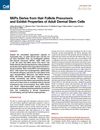Concise Review: Tissue-Engineered Skin and Nerve Regeneration in Burn Treatment
June 2013
in “
Stem Cells Translational Medicine
”
tissue-engineered skin nerve regeneration burn treatment autologous cells dermal scaffolds Schwann cells laminin collagen sponge nerve fibers sensory perception hyperesthesia hair bud-like structures patient-derived stem cells hair follicles tactile sensors skin grafts nerve cells skin cells collagen stem cells hair cells touch sensors

TLDR New methods for skin and nerve regeneration can improve healing and feeling after burns.
In the 2013 review, the authors examined the progress in tissue-engineered skin and nerve regeneration for burn treatment. They discussed the limitations of traditional skin grafts and the importance of restoring sensory functions to improve patient quality of life. The review detailed the use of autologous cells and dermal scaffolds in creating tissue-engineered skin and highlighted the significance of Schwann cells and laminin in nerve regeneration. The study demonstrated that adding laminin to the collagen sponge increased nerve fibers and improved sensory perception without causing hyperesthesia. Incorporating Schwann cells resulted in more sensory fibers and better sensory recovery in mice. The presence of hair bud-like structures also accelerated and directed nerve regeneration. The potential of using patient-derived stem cells to produce Schwann cells and hair follicles was discussed to further enhance nerve regeneration and touch recovery. The conclusion stressed the need to include tactile sensors in tissue-engineered skin for better healing outcomes after burns. The research was supported by the Canadian Institutes of Health Research and involved a doctoral scholarship recipient, M.B.












